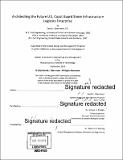Architecting the future U.S. Coast Guard shore infrastructure logistics enterprise
Author(s)
Obermeier, David J
DownloadFull printable version (29.51Mb)
Alternative title
Architecting the future US Coast Guard shore infrastructure logistics enterprise
Architecting the future United States Coast Guard shore infrastructure logistics enterprise
Architecting the future USCG SILC
Other Contributors
Massachusetts Institute of Technology. Engineering Systems Division.
Advisor
Donna H. Rhodes.
Terms of use
Metadata
Show full item recordAbstract
Just over a decade ago, the United States Coast Guard (USCG) initiated radical changes to its doctrine and business model for mission support. A series of "logistics centers" and "service centers" were established and were organized around four management cornerstones: Product Line Management, Configuration Management, Bi-level Maintenance, and Total Asset Visibility. For the organizational element responsible for logistics related to shore infrastructure (piers, runways, office buildings, etcetera), this meant transforming what were then called the "Maintenance and Logistics Command Shore Divisions" from a loose set of regional project management organizations to a centrally managed asset management organization known as the "Shore Infrastructure Logistics Center" (SILC). Now, seven years after this fundamental reorganization, several hurdles still obstruct the USCG shore infrastructure enterprise from fully achieving its strategic goals; there are also longstanding problems that the new enterprise structure has yet to overcome, as well as emerging challenges associated with higher standards, declining budgets, and environmental changes. This thesis argues that the hurdles, persistent problems, and limited capabilities to handle emergent challenges are due to an incomplete and insufficient transformation effort, and that a systems approach to "architecting the enterprise" can position the SILC to most effectively manage the USCG shore infrastructure portfolio. To demonstrate the applicability and efficacy of a systems approach, this thesis applies the Architecting Innovative Enterprise Strategies (ARIES) Framework, developed by Nightingale and Rhodes. The seven step ARIES process reveals that the current "SILC 2.0" enterprise is a step in the right direction, but that a new enterprise architecture is required to align resources with levels of service so that the organization will be capable of affordably achieving strategic enterprise goals. Specifically, the process identifies key upstream transformation drivers, recommends a future enterprise architecture, and dictates an implementation approach that will most efficiently transform the enterprise. The findings not only illustrate the applicability and benefits of system architecting to the USCG shore infrastructure enterprise, but to the industries in which SILC operates.
Description
Thesis: S.M. in Engineering and Management, Massachusetts Institute of Technology, School of Engineering, System Design and Management Program, Engineering and Management Program, 2016. Cataloged from PDF version of thesis. Includes bibliographical references (pages 135-137).
Date issued
2016Department
Massachusetts Institute of Technology. Engineering and Management Program; System Design and Management Program.Publisher
Massachusetts Institute of Technology
Keywords
Engineering and Management Program., System Design and Management Program., Engineering Systems Division.